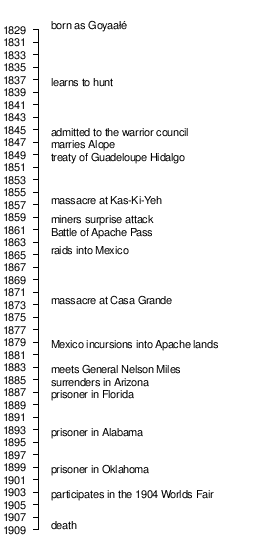
Back جيرانيمو Arabic جيرانيمو ARZ Ceronimo AZ Джеронимо Bulgarian Geronimo BR Gerónimo Catalan گیرۆنیمۆ CKB Geronimo Czech Geronimo CY Geronimo Danish
Geronimo | |
|---|---|
| Goyaałé | |
 Photograph by Frank Rinehart, 1898 | |
| Bedonkohe Apache leader | |
| Preceded by | Juh |
| Personal details | |
| Born | June 16, 1829 No-doyohn Cañon, Arizona[1] |
| Died | February 17, 1909 (aged 79) Fort Sill, Oklahoma, U.S. |
| Resting place | Apache Indian Prisoner of War Cemetery, Fort Sill 34°41′49″N 98°22′13″W / 34.696814°N 98.370387°W, |
| Spouse(s) | Alope, Ta-ayz-slath, Chee-hash-kish, Nana-tha-thtith, Zi-yeh, She-gha, Shtsha-she, Ih-tedda, and Azul |
| Children | Chappo, Dohn-say |
| Mother tongue | Apache, Spanish |
| Signature | |
|
Geronimo's chronology |
 |
Geronimo (Mescalero-Chiricahua: Goyaałé, Athapascan pronunciation: [kòjàːɬɛ́], lit. 'the one who yawns'; June 16, 1829 – February 17, 1909) was a military leader and medicine man from the Bedonkohe band of the Ndendahe Apache people. From 1850 to 1886, Geronimo joined with members of three other Central Apache bands – the Tchihende, the Tsokanende (called Chiricahua by Americans) and the Nednhi – to carry out numerous raids, as well as fight against Mexican and U.S. military campaigns in the northern Mexico states of Chihuahua and Sonora and in the southwestern American territories of New Mexico and Arizona.
Geronimo's raids and related combat actions were a part of the prolonged period of the Apache–United States conflict, which started with the Americans continuing to take land, including Apache lands, following the end of the war with Mexico in 1848. Reservation life was confining to the free-moving Apache people, and they resented restrictions on their customary way of life.[2] Geronimo led breakouts from the reservations in attempts to return his people to their previous nomadic lifestyle. During Geronimo's final period of conflict from 1876 to 1886, he surrendered three times and eventually accepted life on the Apache reservations. While well-known, Geronimo was not a chief of the Bedonkohe band of the Central Apache but a shaman, as was Nokay-doklini among the Western Apache.[3][4] However, since he was a superb leader in raiding and warfare, he frequently led large numbers of 30 to 50 Apache men.[4]
In 1886, after an intense pursuit in northern Mexico by American forces that followed Geronimo's third 1885 reservation breakout, Geronimo surrendered for the last time to Lt. Charles Bare Gatewood. Geronimo and 27 other Apaches were later sent to join the rest of the Chiricahua tribe, which had been previously exiled to Florida.[5] While holding him as a prisoner, the United States capitalized on Geronimo’s fame among non-Indians by displaying him at various fairs and exhibitions. In 1898, for example, Geronimo was exhibited at the Trans-Mississippi Exposition in Omaha, Nebraska; seven years later, the Indian Office provided Geronimo for use in a parade at the second inauguration of President Theodore Roosevelt. He died at the Fort Sill hospital in 1909, as a prisoner of war, and was buried at the Fort Sill Indian Agency Cemetery, among the graves of relatives and other Apache prisoners of war.
- ^ Geronimo (1996). Barrett, S. M.; Turner, Frederick W. (eds.). Geronimo: his own story. New York: Penguin. ISBN 978-0-452-01155-7. Archived from the original on January 5, 2020. Retrieved November 12, 2015.
- ^ Utley 2012, pp. 152, 153.
- ^ Debo 1996, p. 38.
- ^ a b Utley 2012, pp. 1, 2.
- ^ Debo 1996, p. 268.